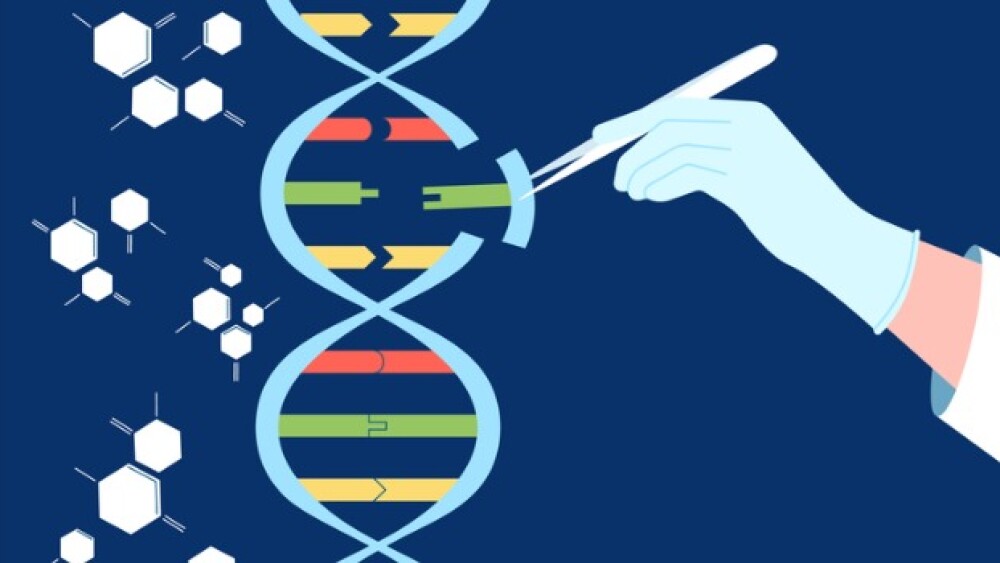Following the December and January approvals of Vertex Pharmaceuticals and CRISPR Therapeutics’ Casgevy, analysts believe another CRISPR approval is unlikely in the near future.
Pictured: Illustration of a gloved hand holding tweezers and editing DNA/iStock, LadadikArt
The era of CRISPR gene-editing technology has arrived. With the approval of Vertex Pharmaceuticals and CRISPR Therapeutics’ Casgevy (exa-cel) in two indications, the question now is, what’s next?
In short, the answer to that question is not much right now. While the cell and gene therapy sector as a whole is expecting continued growth in terms of approvals, CRISPR-based therapies are predominately early stage.
CRISPR Pipeline Skews Toward Discovery
The December and January approvals of Casgevy for sickle cell disease and transfusion-dependent beta thalassemia represent a landmark for gene therapy. Casgevy is the first approved treatment that uses CRISPR/Cas9 gene-editing technology. The one-time treatment can be curative for these serious, life-altering blood disorders.
But Casgevy will not open any immediate floodgates to CRISPR therapy approvals, as most potential CRISPR-based treatments are still in the earlier stages of development. According to a December 2023 report from GlobalData, discovery and preclinical assets account for 88% of the CRISPR drug candidates currently under investigation, with 24 CRISPR-based therapeutics in Phase II trials and one other than Casgevy in Phase III.
Thus, despite the milestone approval of Casgevy, GlobalData analyst Jasper Morley believes the industry is “unlikely to see another [CRISPR] drug approval in the near future.”
While hematological drugs are the most advanced, out of 262 active drugs in the discovery and preclinical stage, oncology dominates—accounting for some 25%—Morley told BioSpace in an email. Hematological disorders account for about 10%.
“This finding suggests that companies beginning to develop CRISPR drugs are looking at therapy areas which are alternatives to the Casgevy approvals,” Morley said.
The other Phase III candidate is Intellia Therapeutics and Regeneron Pharmaceuticals’ NTLA-2001 for transthyretin (ATTR) amyloidosis with cardiomyopathy, a rare, progressive and fatal disease. In October, the FDA cleared a pivotal study of the in vivo CRISPR-based gene editor. If successful, it could be the first single-dose treatment for ATTR amyloidosis.
CRISPR therapy development at this point is led by smaller companies. Big pharma is expected to partner with these small companies, opting to in-license their technology, Morley said.
Challenges for CRISPR
Morley spoke of several roadblocks to the rapid growth of CRISPR-based therapies. “Challenges in this space include how to develop a fair pricing strategy, the logistics of offering broad access to the most needy populations in underserved markets (such as sickle cell patients in Africa), and potential unfamiliar adverse events associated with this novel modality of therapy.”
Vertex and CRISPR’s Casgevy will run $2.2 million for a one-time treatment for both SCD and TDT. That sticker price is in line with other novel gene therapies, such as bluebird bio’s Lyfgenia, which was also approved by the FDA for SCD and will cost $3.1 million. Yet one study of SCD patients found the total cost of disease over a patient’s lifetime was over $5 million.
Alliance for Regenerative Medicine CEO Tim Hunt pointed this out in San Francisco earlier this month at the Biotech Showcase during JPM Week. “I know there’s sticker shock when you price the product at $2 million to $3 million. But if you look at the data, it tells a very compelling story,” he said.
Part of Casgevy’s high cost comes from the extensive chemotherapy patients must undergo before treatment to make way for the reengineered cells. Vertex is currently working with hospitals to establish a network of authorized treatment centers (ATCs) to offer the therapy to patients, with more coming online “in the coming weeks,” the company said in a December announcement.
One way to reduce cost and the complexity of administration is to develop in vivo gene therapies, instead of manipulating patients’ cells ex vivo. Casgevy’s co-developer CRISPR Therapeutics has plans to announce in vivo editing programs later this year, the company’s head of research Jon Terrett told BioSpace.
“We believe the CAR T, liver knockout and iPSC platforms are scalable and adaptable to further programs and we plan to advance preclinical candidates to rapidly advance new programs with these platforms,” Terrett said.
The company’s CRISPR/Cas9 allogeneic CAR T programs are aimed at CD19+ malignancies, autoimmune disease, solid tumors and blood cancers. A clinical trial for CTX112 for systemic lupus erythematosus is initiating in the first half of this year. CD19-directed CAR T therapies have shown effectiveness in producing long-lasting remissions in multiple autoimmune indications, Terrett said.
He believes the future of CRISPR therapies includes rare disease “correction,” regenerative medicine and fighting solid tumors.
CRISPR 2.0 Could Be Next
As CRISPR technology makes its debut in approved medicines, some attention has already shifted to newer modalities. Base editing, for example, is a derivative of CRISPR that can modify DNA without making the breaks that risk leading to cancerous mutations and is now in clinical development.
Verve Therapeutics has a single-course in vivo liver base editing treatment in a Phase Ib trial for patients with familial high cholesterol who are at significantly increased risk for heart attack and stroke. A patient treated with its higher dosage experienced a 55% reduction in LDL-C for at least 180 days, with follow up ongoing. Meanwhile, Beam Therapeutics dosed its first patient with BEAM-201, a base editing therapy for aggressive forms of blood cancers, in September.
CRISPR Therapeutics has also prioritized the development of the next generation of CRISPR gene-edited CAR T candidates, though Terrett said there are still “so many possibilities with conventional CRISPR/Cas9 which continues to gain clinical experience.”
Whichever form of CRISPR is the next to hit the market, there’s no question that the market is maturing. GlobalData estimates that by 2029, 20 CRISPR drugs will generate more than $7 billion annually.
Kate Goodwin is a freelance life science writer based in Des Moines, Iowa. She can be reached at kate.goodwin@biospace.com and on LinkedIn.






